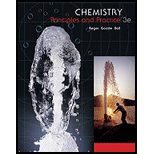
Concept explainers
Interpretation:
The mass of sodium used in a reaction when
Concept Introduction:
In any stoichiometric balanced equation, the reactant that is present in the least amount and that governs the amount of products formed is known as limiting reactant.
Prior to the identification of the limiting reactant; a balanced equation is written, then the amount of each reactant in grams is converted to corresponding moles. Further on the basis of the stoichiometric molar ratio by which reactants combine, the amount of product formed from each of the reactants is calculated.
Answer to Problem 6.90QE
The mass of sodium used in a reaction is
Explanation of Solution
The conversion factor to convert liters to milliliters is as follows:
Hence convert
The barometric pressure is the total pressure measured and the vapor pressure of the water at
The total pressure as per Dalton’s law of partial pressure is calculated as follows:
Here,
Substitute
Rearrange the expression to obtain the value of
Therefore the partial pressure corresponding to
The conversion factor to convert
Therefore
The formula to convert degree Celsius to kelvin is as follows:
Substitute
The formula to calculate the number of moles as per the ideal gas equation is as follows:
Substitute
The balanced reaction when sodium reacts with water is given as follows:
According to the stoichiometry of the balanced equation (4),
The formula to convert mass in gram to moles is as follows:
Substitute
Want to see more full solutions like this?
Chapter 6 Solutions
Chemistry
- Given that a sample of air is made up of nitrogen, oxygen, and argon in the mole fractions 0.78 N2, 0.21 O2, and 0.010 Ar, what is the density of air at standard temperature and pressure?arrow_forwardHeavy water, D2O (molar mass = 20.03 g mol-1). can be separated from ordinary water, H2O (molar mass = 18.01), as a result of the difference in the relative rates of diffusion of the molecules in the gas phase. Calculate the relative rates of diffusion of H2O and D2O.arrow_forwardIn the discussion on the composition of air, mention is made of the fact that water vapor may have a concentration as high as 40,000 ppm. Calculate the partial pressure exerted by water vapor at this concentration. Assume that this represents a situation with 100% humidity. What temperature would be needed to achieve this value? (See Appendix G.)arrow_forward
 Chemistry: An Atoms First ApproachChemistryISBN:9781305079243Author:Steven S. Zumdahl, Susan A. ZumdahlPublisher:Cengage Learning
Chemistry: An Atoms First ApproachChemistryISBN:9781305079243Author:Steven S. Zumdahl, Susan A. ZumdahlPublisher:Cengage Learning Chemistry: Principles and PracticeChemistryISBN:9780534420123Author:Daniel L. Reger, Scott R. Goode, David W. Ball, Edward MercerPublisher:Cengage Learning
Chemistry: Principles and PracticeChemistryISBN:9780534420123Author:Daniel L. Reger, Scott R. Goode, David W. Ball, Edward MercerPublisher:Cengage Learning Chemistry for Engineering StudentsChemistryISBN:9781337398909Author:Lawrence S. Brown, Tom HolmePublisher:Cengage Learning
Chemistry for Engineering StudentsChemistryISBN:9781337398909Author:Lawrence S. Brown, Tom HolmePublisher:Cengage Learning
 Principles of Modern ChemistryChemistryISBN:9781305079113Author:David W. Oxtoby, H. Pat Gillis, Laurie J. ButlerPublisher:Cengage Learning
Principles of Modern ChemistryChemistryISBN:9781305079113Author:David W. Oxtoby, H. Pat Gillis, Laurie J. ButlerPublisher:Cengage Learning Chemistry: The Molecular ScienceChemistryISBN:9781285199047Author:John W. Moore, Conrad L. StanitskiPublisher:Cengage Learning
Chemistry: The Molecular ScienceChemistryISBN:9781285199047Author:John W. Moore, Conrad L. StanitskiPublisher:Cengage Learning





